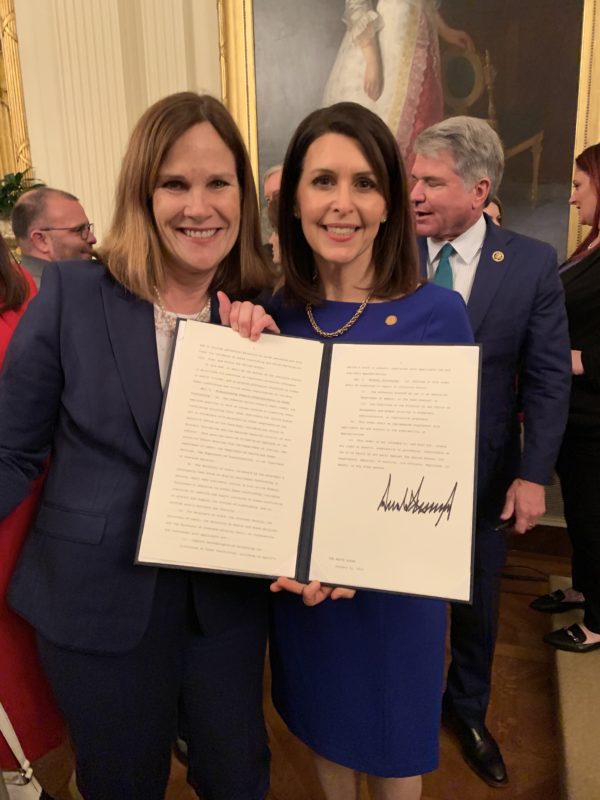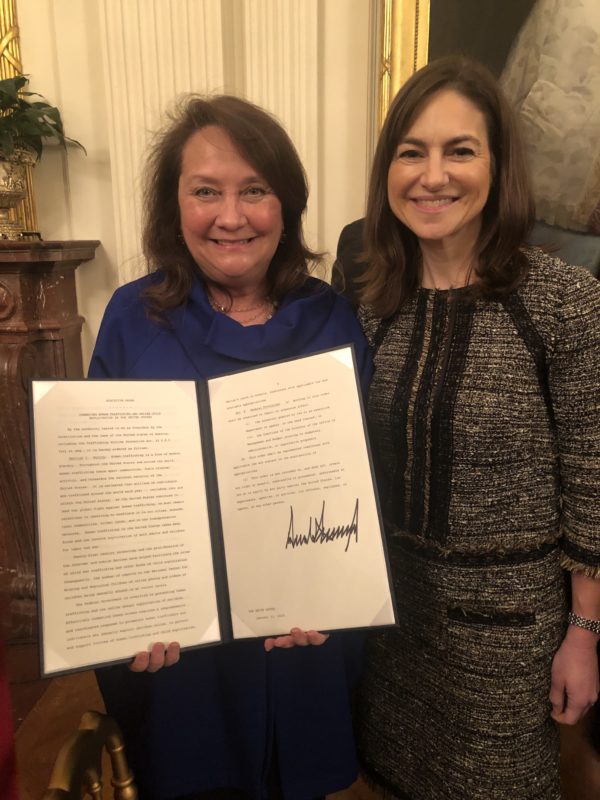Human Trafficking: New Executive Order Sheds Light on Prevention, Protection and Prosecution
By Sylvie Legere
I had the honor of participating in a summit at the White House on Human Trafficking last week to mark Human Trafficking Prevention Month, as well as the 20th anniversary of the Antitrafficking Act on January 31st. This is an issue that can feel remote to some – but whether it’s an urban center, suburb or rural area, it’s unfortunately something that touches each of our communities. To end it, we must build awareness around prevention, protection and prosecution, and we must coordinate at all levels locally, federally and globally.
At the event, Ivanka Trump framed the problem and initiatives that her office has spearheaded to prevent trafficking through education, protect victims and prosecute predators. The President signed an Executive Order that allocates $42 million dollars and creates a new position focused on domestic policy against human trafficking.
A panel of practitioners from several states, cities, county law enforcement groups, and Native American reservations presented examples of collaboration and coordination to stop trafficking.
Another panel of State Representatives discussed how legislation have evolved in the last 20 years with last year passage of an amendment to Section 230 of the Communication Decency Act to prosecute websites hosting human trafficking. The Commissioner from Minnesota stated that his part of combating trafficking is to reach out to men’s groups, sponsoring awareness programs on the topic. A judge from a California Native American tribe told the story of his own daughter being the victim of trafficking through social media.
The event was attended by Department of Justice’s William Barr, the head of Health and Human Services Alex Azar, Chris Rey and Vice President Pence. The culmination of the event was when President Trump signed the Executive Order committing his administration to act on this problem domestically and lead the world to end it.
What you need to know about human trafficking:
We often think only of child sex trafficking, but there is also labor trafficking in agriculture, hospitality, construction, domestic help, even in medicine as revealed last week with Cuban doctors suing the UN for participating in their trafficking to Brazil remote villages in the Amazon.
In layman’s terms, trafficking is forcing someone into activities against their will. The Trafficking Victims Protection Act of 2000 (TVPA) defines “severe forms of trafficking in persons” as:
- Sex trafficking in which a commercial sex act is induced by force, fraud, or coercion, or in which the person induced to perform such an act has not attained 18 years of age; or
- The recruitment, harboring, transportation, provision, or obtaining of a person for labor or services, through the use of force, fraud, or coercion for the purpose of subjection to involuntary servitude, peonage, debt bondage, or slavery
According to a September 2017 report from the International Labor Organization (ILO) and Walk Free Foundation, An estimated 24.9 million victims are trapped in modern-day slavery. Of these, 16 million (64%) were exploited for labor, 4.8 million (19%) were sexually exploited, and 4.1 million (17%) were exploited in state-imposed forced labor. Other key statistics you should know:
- Estimates of slaves worldwide are between 21 and 32 million, the vast majority from vulnerable populations (immigrants, refugees, poor, children).
- Human trafficking globally generates $150 billion in illegal profits per year – $99 billion from sex trafficking and $51 billion from labor trafficking (2014 numbers).
- Asia-pacific region accounts for largest number of forced laborers (15.4 million); Africa 5.7 million, Europe/Central Asia 2.2 million; Americas 1.2 million.
- Nearly 80% of human trafficking is for sex, remaining 20% for labor exploitation.
- “Out of nearly 25,000 runaway youth reported, an estimated one out of seven were likely child sex trafficking victims. Of those, 88% were in the care of social services when they went missing.”
The key to winning this battle against trafficking is eliminating demand through awareness and education. Across the board, Americans need a better understanding of the issue, an ability to recognize the signs and engage with victims in a non-intimidating way. There also needs to be more collaboration with communities and non-profits to direct victims to safe havens where they can rebuild their lives. For prosecution to be effective local, state and federal law enforcement agencies need to work together across county, state, international borders. Predators move their victims where there is demand at events like the Super Bowl and in urban centers but also in remote areas with little access to the economic benefits of other communities.
It was a full event and I had the opportunity to meet the Miami Law Enforcement Chair of Against Human Trafficking, a Minnesota County Commissioner who leads the effort in his state, First Lady Cecelia Abbott and Andrea Sparks from Texas, and I happen to sit next to the head of the the UN agency against trafficking in Vienna. There’s also only 1 degree of separation to The Policy Circle: I ran into Michigan State Representatives Mary Whiteford and Bronna Kahle, who seeded a circle in Grand Rapids, and who lead awareness campaigns and legislation in Michigan!
Several Policy Circle members and supporters have told me about their engagement to end human trafficking, so I am grateful for the day, for the people that I met there and for what I learned. I have a new personal commitment to raise awareness about it in my community. Because of the interest in this topic, The Policy Circle team has been exploring how to frame it into a new brief. Stay tuned – we will be developing this brief for release this Spring.
Here are 20 additional ways you can help fight human trafficking in 2020. Do you have additional resources to share or want to offer expertise for the Human Trafficking brief? Contact us at communications@thepolicycircle.org.
Connection is at the heart of The Policy Circle’s model and mission. More than 3,000 women across the country gather regularly to learn about public policy and take action in their communities. Circles provide a safe, encouraging environment that fosters friendship and purpose. We celebrate our shared love of country, community and our growing tribe of women who are changing the conversation.
Want to share your Policy Circle story? Email us at info@thepolicycircle.org to learn how to get involved.

